
 Image: IDG / Matthew Smith
Image: IDG / Matthew Smith
At a glance
Expert’s Rating
Pros
Gorgeous OLED displayThin and light1440p webcamGood processor performance
Cons
Drab design and material quality Small touchpadDoesn’t have discrete graphicsBattery life is a bit behind the curve
Our Verdict
Acer’s Swift Go 14 goes all-in on Intel’s Core i7-13700H, and it doesn’t pay off.
Price When Reviewed
$1,099.99
Best Prices Today: Acer Swift Go 14
RetailerPrice

Acer’s Swift line is often a go-to for shoppers looking to buy a portable laptop with solid performance at a low price. The new Acer Swift Go 14 doesn’t entirely spoil that formula, but the decision to stick with Intel’s disappointing integrated graphics is a problem.
Looking for more options? Check out PCWorld’s roundup of the best laptops available today.
Acer Swift Go 14: Specs and features
The Acer Swift Go 14 leans heavily on Intels’ Core i7-13700H processor. This 14-core chip is common in a variety of laptops but rarely seen in a 14-inch laptop that’s priced at just $1,100.
CPU: Intel Core i7-13700HMemory: 16GB LPDDR5Graphics/GPU: Intel Iris XeDisplay: 14-inch 2880 x 1800 OLED 90HzStorage: 512GB PCIe Gen4 SSDWebcam: 1440p Connectivity: 2x Thunderbolt 4/USB-C, 2x USB-A, MicroSD card reader, 3.5mm combo audio jackNetworking: WiFi 6E, BluetoothBiometrics: NoneBattery capacity: 65 watt-hoursDimensions: 12.32 x 8.6 x .59Weight: 2.87 poundsMSRP: $1,099.99
Unfortunately, choosing this speedy processor leaves no room to provide discrete graphics, so Intel Iris Xe integrated graphics is the only choice.
Acer Swift Go 14: Design and build quality
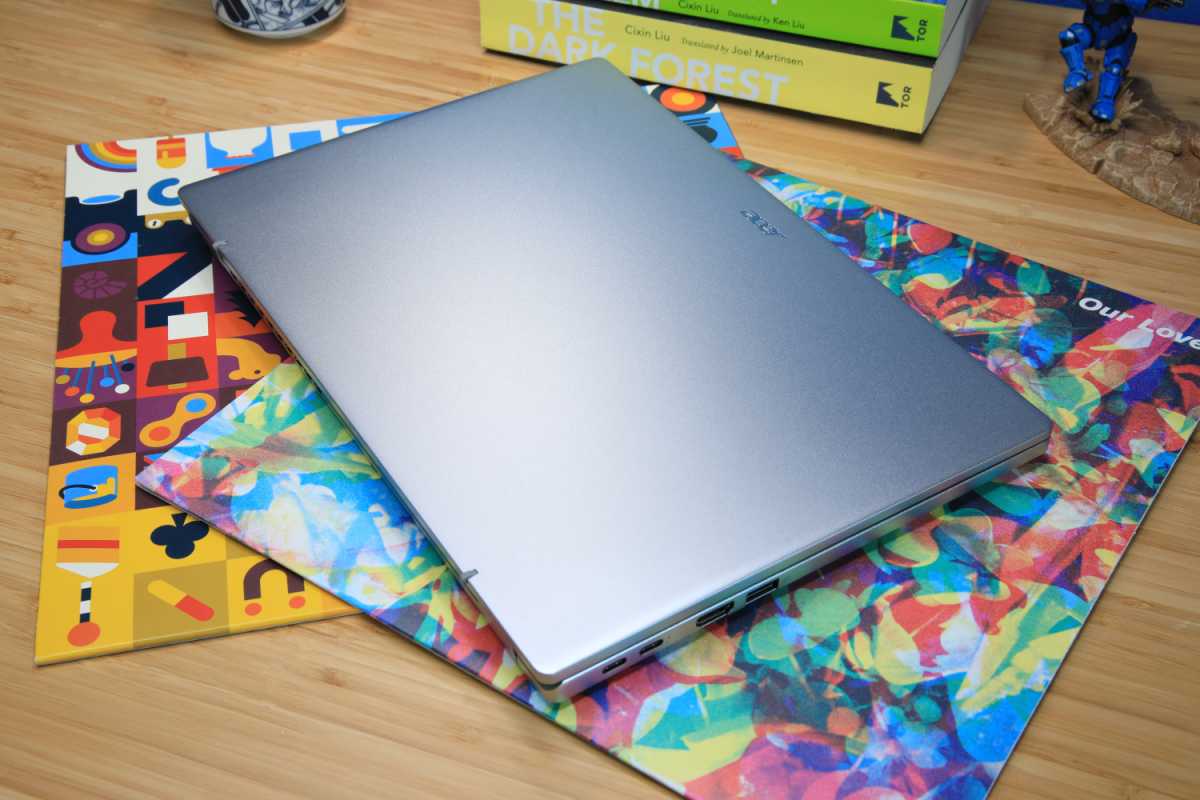
IDG / Matthew Smith
IDG / Matthew Smith
IDG / Matthew Smith
Acer’s Swift Go 14 doesn’t stand out at a glance. Its metal and plastic enclosure is clad in what’s quite possibly the most generic shade of silver known to exist, and the chassis otherwise lacks design traits that might help it stand out. There’s no functional problems with this design, but those who care at all about the look of their laptop will find little excitement here.
The laptop’s material quality is mundane. Acer opts to use metal along the display lid and interior but plastic on the undercarriage, which cheapens the feel of the laptop when it’s carried. It also allows minor chassis flex when the laptop is open. The metal display lid is rather rigid, at least, and allows minimal flex while opening or closing the laptop. Still, this is an area the Acer Swift Go 14 falls way behind more luxurious competitors like the Apple MacBook Pro 14 and Microsoft Surface Laptop 5.
Acer’s use of inexpensive materials seems to pay off in weight, though, as the Swift Go 14 tips the scales at a feathery 2.87 pounds. It’s also a mere .59 inches thick and measures only 12.32 inches wide. True to its name, this laptop is easy to throw in a bag for travel and is light enough to feel almost unnoticeable in a backpack.
Acer Swift Go 14: Keyboard, trackpad
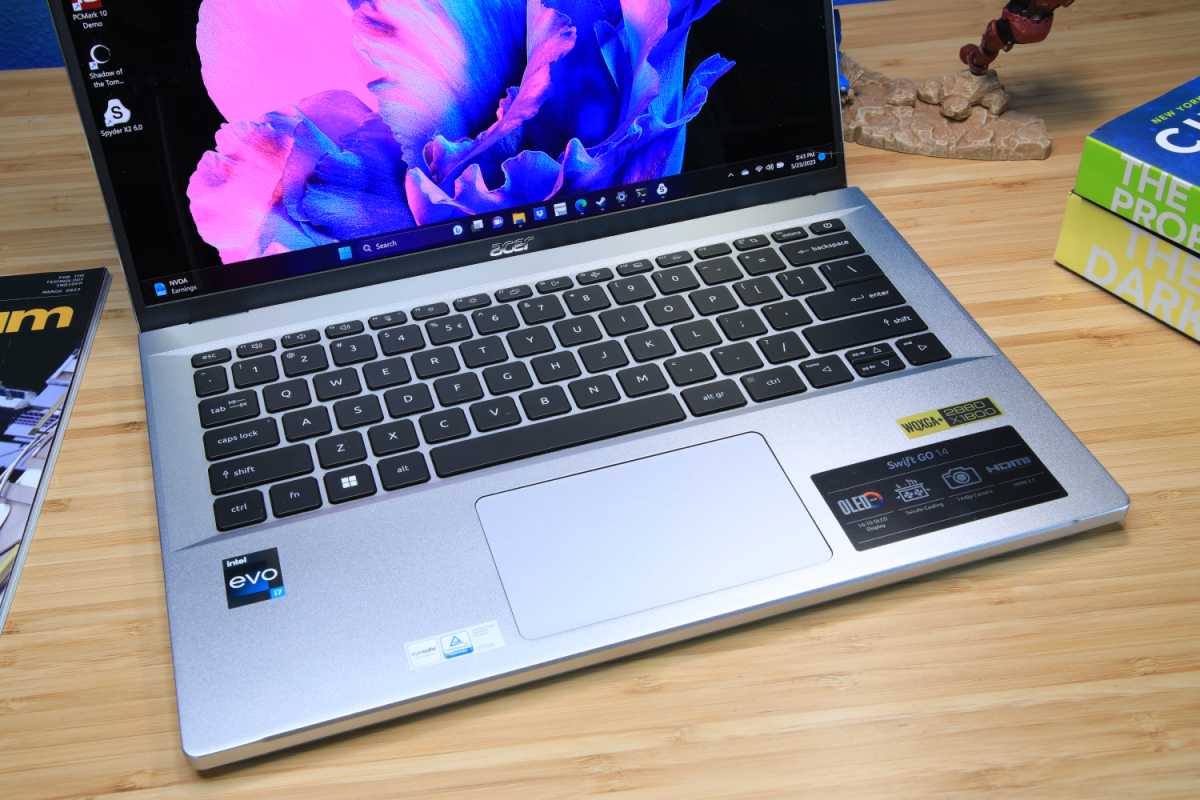
IDG / Matthew Smith
IDG / Matthew Smith
IDG / Matthew Smith
The Acer Swift Go 14 has a spacious keyboard without a numpad—unsurprising, as a 14-inch display generally doesn’t provide enough room to add one. It’s a comfortable and familiar layout with large keys. Key feel is adequate: keys seem to have good travel but bottom with a mushy feel that doesn’t provide a great tactile sensation. Still, I used the keyboard to type several thousand words without issue.
A basic white LED keyboard backlight is standard. When I say basic, I mean it—it has two brightness settings and that’s it. I would prefer a larger number of brightness settings and a higher brightness at maximum.
Acer makes do with a surprisingly small touchpad that measures roughly four inches across and 2.5 inches deep. The touchpad’s surface is responsive but the limited space can make multi-touch gestures feel awkward. I also had a few problems with unintended inputs, an inconvenience I wouldn’t expect from a touchpad this small.
Acer Swift Go 14: Display, audio
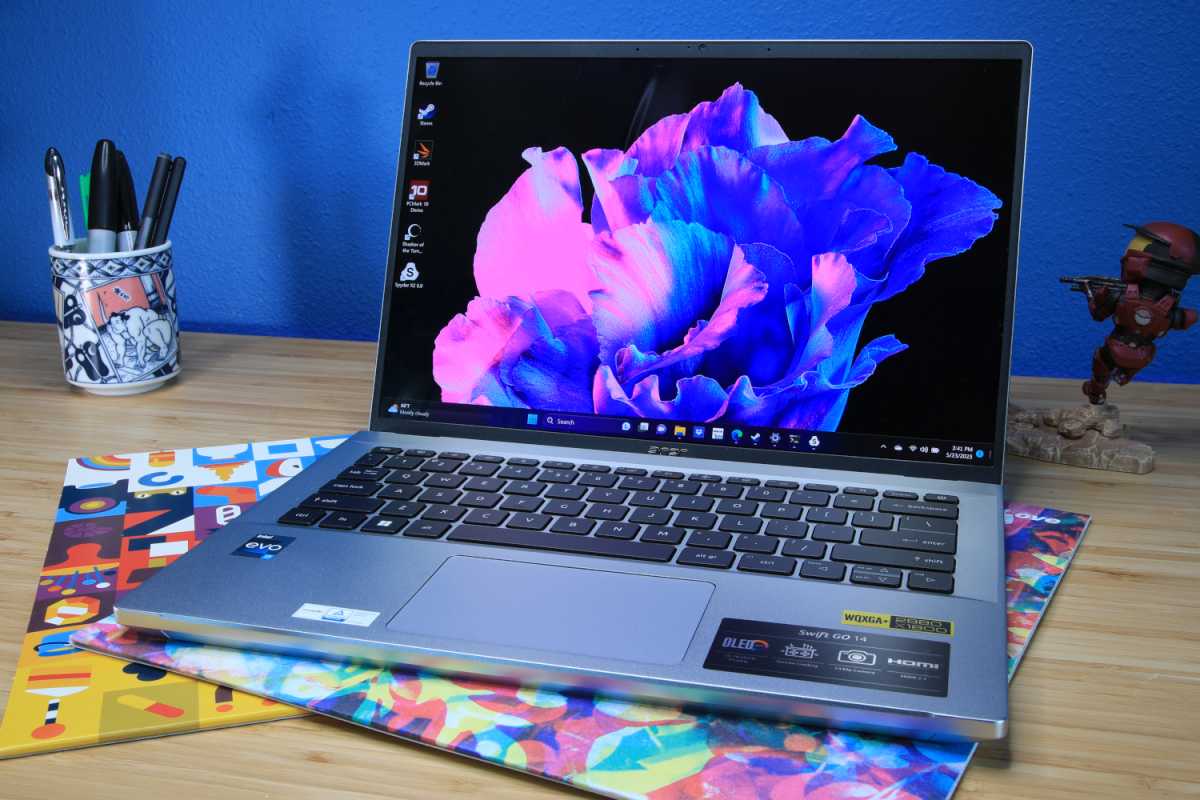
IDG / Matthew Smith
IDG / Matthew Smith
IDG / Matthew Smith
The Acer Swift Go 14 has a 14-inch OLED display with 2880×1800 resolution and a maximum refresh rate of 90Hz. It’s a crisp, sharp, fluid display that looks beautiful in every situation. It offers an effectively infinite contrast ratio thanks to its ability to deliver a perfect lack of luminance in extremely dark scenes, yet pairs that with a maximum brightness of up to 440 nits, which is bright enough for use in a sunlit room.
Color performance is excellent, as well. The display spans the entire sRGB and DCI-P3 color gamuts and provides strong color accuracy. This translates to a vivid, saturated look in movies and games. It also provides benefits to content creators who want to work in a wide color gamut.
HDR is supported and content looks attractive, but the upgrade over SDR is often marginal. This is due to the laptop’s brightness which, although excellent for an OLED laptop, is not high enough to really deliver a wallop in HDR movies and games. Mini-LED laptop displays are a superior choice for HDR, but they’re only found in a handful of much more expensive laptops, such as the Razer Blade 16.
Motion clarity is a highlight. The display’s 90Hz refresh rate isn’t impressive on paper but benefits from OLED’s low pixel response times. This in turn reduces motion blur and provides good detail in fast-moving scenes. This is most noticeable in PC games, but I also found the improvement noticeable while scrolling through web pages or documents.
The speakers aren’t as alluring as the display. They provide good volume but are easily overwhelmed in music, movies, and games. Distortion creeps in from the low end and muddies the mid-range which, at times, sounds harsh and metallic. The speakers are fine for video calls or podcasts but otherwise fail to impress.
Acer Swift Go 14: Webcam, microphone, biometrics
Acer delivers a surprise in the Swift Go 14’s webcam. It has a maximum resolution of 2560×1440 and provides remarkable video quality for a laptop webcam. Recorded video looks sharp and offers rich, realistic color. The image will still be grainy in low light, but no more so than any other webcam.
Microphone quality is strong, too, thanks to a dual-array microphone with noise cancellation. Recorded audio sounds tinny and hollow but remains crisp and delivers good volume. It’s a good match for video meetings.
Biometric login is absent from the Swift Go 14. That’s a bit disappointing, but not surprising at this price point.
Acer Swift Go 14: Connectivity
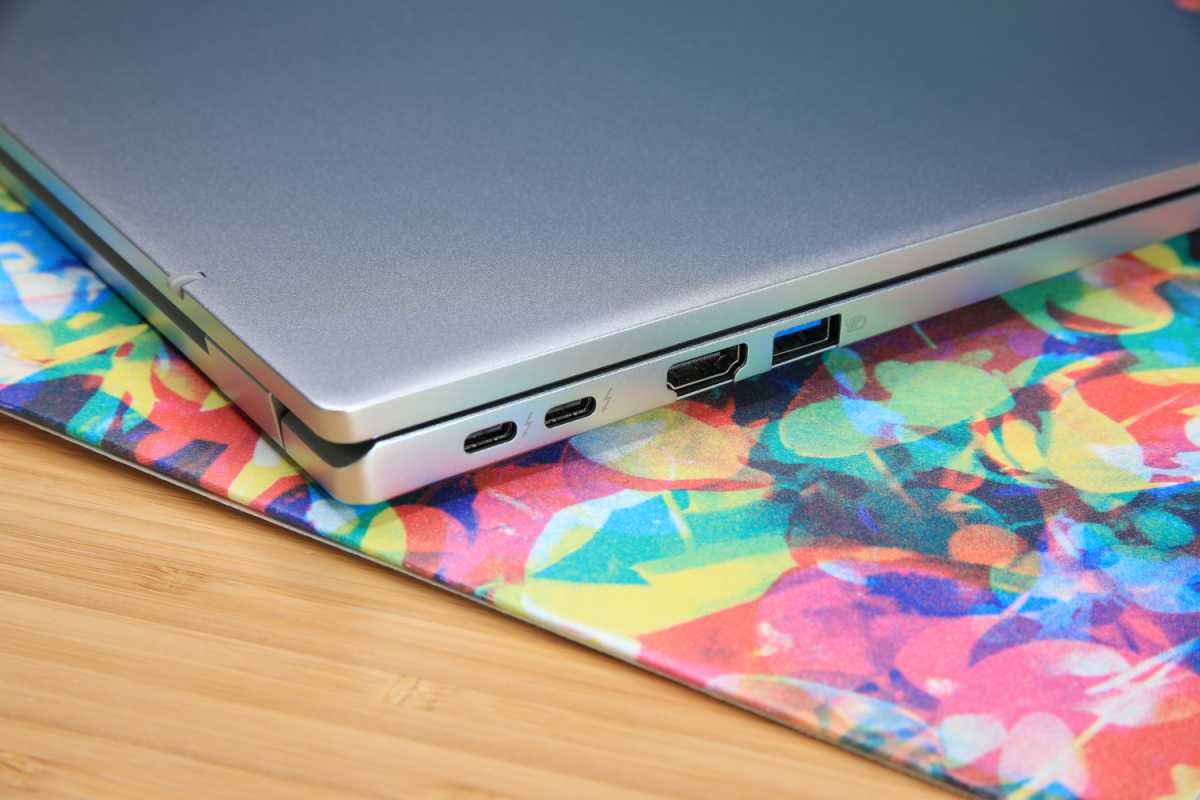
IDG / Matthew Smith
IDG / Matthew Smith
IDG / Matthew Smith
The laptop’s physical connectivity includes two Thunderbolt 4 / USB-C 3.2 Gen 2 ports. Both support Power Delivery, so both can be used to charge the laptop or connect with either the included 100 watt power adapter or a third-party power brick.
A pair of USB-A ports, a MicroSD card reader, and 3.5mm combo audio jack round out the physical connectivity. It’s a good array of options that covers both modern and legacy devices.
Wireless connectivity is provided by Intel Killer Wi-Fi AX1675 with support for Wi-Fi 6E and Bluetooth 5.2. This is good wireless connectivity that covers the latest standards (technically, Bluetooth 5.3 is now available, but it’s a very modest update). Wi-Fi performance was strong in testing, as the laptop can make full use of Gigabit Internet speeds when near a high performance router.
Acer Swift Go 14: Performance
Want processor performance? The Acer Swift Go 14 has you covered. While the entry-level variant has Intel’s Core i7-1355U, the model I tested was equipped with Intel’s more powerful Core i7-13700H. This is a 14-core processor (with six performance cores and eight efficient core) that can hit a maximum clock speed of 5GHz. Acer pairs this configuration with 16GB of LPDDR5 RAM and a 512GB PCIe Gen 4 solid state drive.

IDG / Matthew Smith
IDG / Matthew Smith
IDG / Matthew Smith
PCMark 10, a general system performance benchmark, reports a respectable score of 6,118. This is technically the third-best score in this benchmark, but the range of results is fairly tight, making it hard to report any firm results from this benchmark alone (except, perhaps, that the Microsoft Surface Laptop 5’s older 12th-gen Intel hardware shows its age).
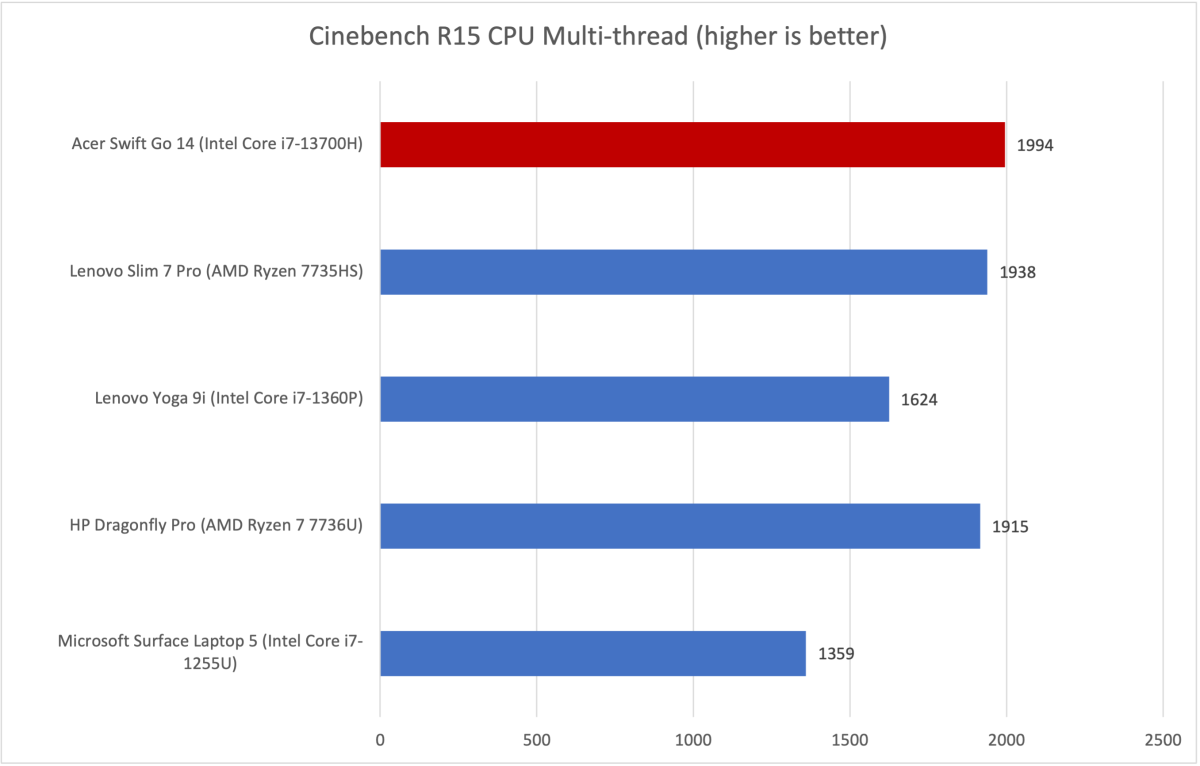
IDG / Matthew Smith
IDG / Matthew Smith
IDG / Matthew Smith
Next up is Cinebench R15, a benchmark that focuses entirely on CPU performance. It reports a very strong score of 1,994, which is the best of any laptop in this competitive set. The range of results remains tight but, in this benchmark, both Microsoft Surface Laptop 5 and Lenovo Yoga 9i start to lag the pack.

IDG / Matthew Smith
IDG / Matthew Smith
IDG / Matthew Smith
The results are more even than Handbrake, a video encoding test, but here the Acer Swift Go 14 begins to break away from the pack. It’s roughly 15 percent quicker than the Lenovo Slim 7 Pro, the next-quickest laptop in this competitive set.
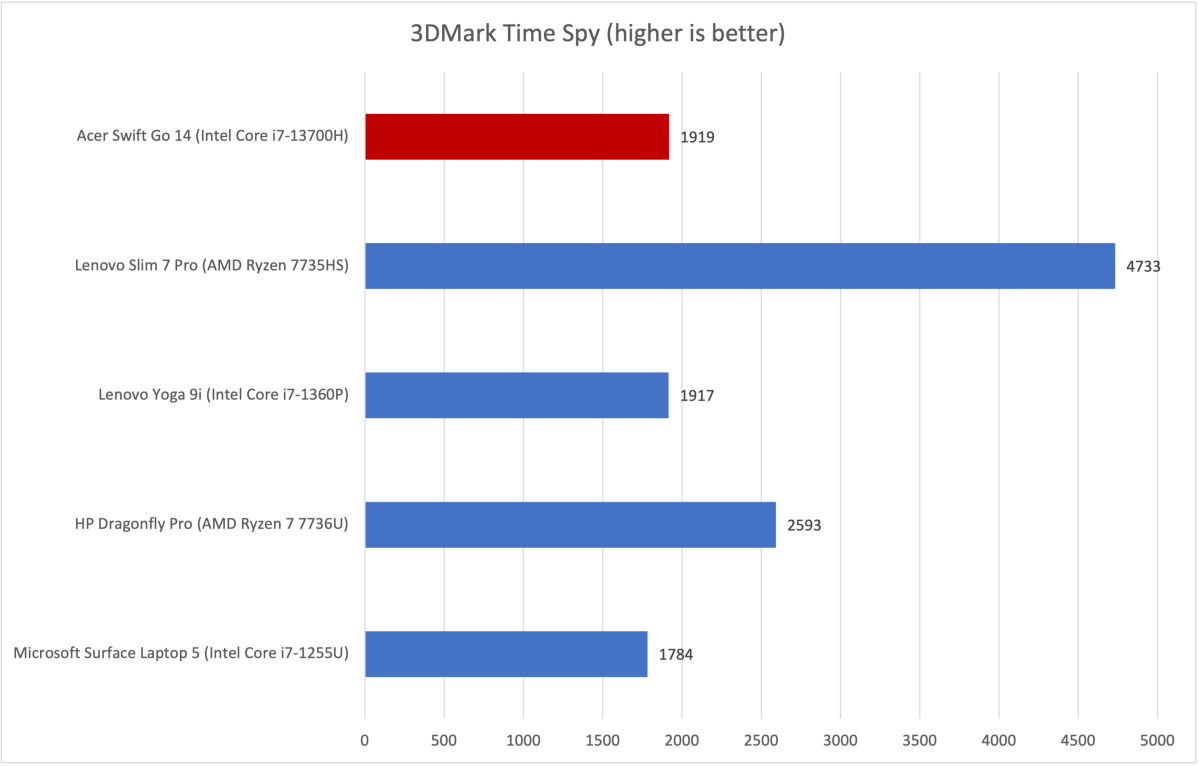
IDG / Matthew Smith
IDG / Matthew Smith
IDG / Matthew Smith
The benchmarks now turn towards the GPU, which is a problem for Acer’s Swift Go 14. It neglects discrete graphics and instead relies on Intel Iris Xe integrated graphics.
3DMark Time Spy shows the results, and they’re not pretty. The Acer falls way behind the Lenovo Slim 7 Pro, a laptop that includes Nvidia RTX 3050 graphics. It also fails to match the HP Dragonfly Pro, which relies on Radeon integrated graphics provided by the Ryzen 7736U processor.
I still gave the Swift 14 Go a shot with Shadows of the Tomb Raider, a game that represents the best visuals from cross-platform games in the PlayStation 4 and Xbox One X generation. It delivered an average of just 22 frames per second at 1080p detail and Highest settings. The game is playable at Low settings, but only just, averaging 31 frames per second—and the framerate can still dip below 30 FPS in gameplay.
Acer clearly leans into processor performance with the Swift Go 14. I don’t think that bet pays off. The problem is simple: AMD’s new Ryzen 7000-series processors are often extremely competitive with Intel processors yet also, in their best incarnations, also provide superior integrated graphics. The Intel Core i7-13700H retains a slight edge in strictly CPU-reliant tasks, but the margin of its victor is not enough to offset the relatively lackluster performance of Intel Iris Xe.
Acer Swift Go 14: Battery life
The Acer Swift 14 Go packs a modest 65 watt-hour battery. That’s not large for a modern laptop with an Intel Core i7-13700H processor, and it shows.

IDG / Matthew Smith
IDG / Matthew Smith
IDG / Matthew Smith
I recorded eight hours and 40 minutes of battery life in a standard test loop through a 4K file of the short film Tears of Steel. That’s a usable result, to be sure, but one that falls behind many competitive laptops. The Lenovo Slim 7 Pro is a particular standout, as it managed to achieve superior battery life in tests despite the inclusion of Nvidia RTX 3050 graphics.
Acer Swift Go 14: Should you buy it?
The new Acer Swift Go 14 bets everything on the performance of Intel’s Core i7-13700H. That bet doesn’t pay off.
It’s true that Intel’s Core i7-13700H can deliver superior performance in CPU-intensive tasks. This, however, requires a sacrifice in graphics performance most potential owners won’t find appealing. The Swift Go 14 also struggles to deliver on battery life despite the lack of discrete graphics, which is a problem for a thin, light laptop. Acer’s inexpensive base MSRP of $1,099.99 helps to forgive these flaws, but it’s ultimately not enough to make the Swift Go 14 stand out from a crowded field of similar laptops.
Best Prices Today: Acer Swift Go 14
RetailerPrice

Author: Matthew S. Smith
Matthew S. Smith is a freelance technology journalist with 15 years of experience reviewing consumer electronics. In addition to PCWorld, his work can be found on Wired, Ars Technica, Digital Trends, Reviewed, IGN, and Lifewire. Matthew also covers AI and the metaverse for IEEE Spectrum and runs Computer Gaming Yesterday, a YouTube channel devoted to PC gaming history.
Recent stories by Matthew S. Smith:
Acer Predator Helios Neo 18 review: A huge gaming laptop for a small priceAcer Chromebook 516 GE review: A cloud gaming powerhouseAsus Zenbook 14 OLED review: A budget laptop star



